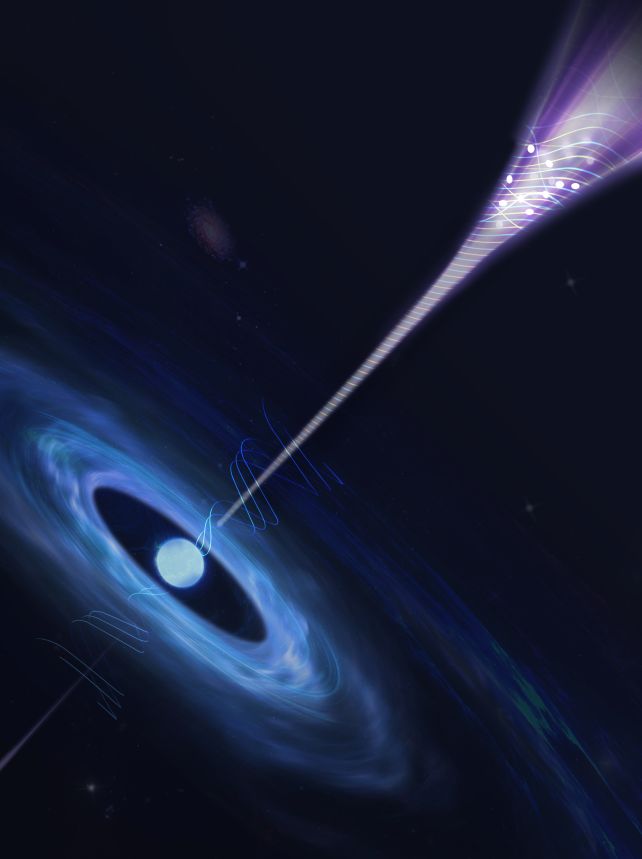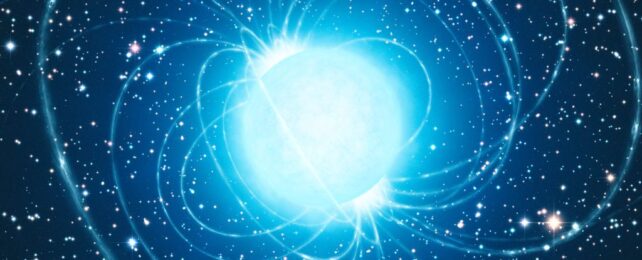Astronomers may have recorded the violent birth of one of the weirdest objects our Universe is capable of producing.
In a bizarre gamma-ray space explosion whose light reached Earth in 2023, a team led by astronomer Run-Chao Chen of Nanjing University in China has detected a signal they say is the birth cry of a newly formed magnetar, the most magnetically extreme objects that exist.
"This is the first time humanity has directly observed a periodic signal from a millisecond magnetar inside a gamma-ray burst," Chen says. "It is like hearing the first heartbeat of a newborn star."
Related: Neutron Star Collision Caught Forging Heavy Metals in a JWST First
Gamma-ray bursts are the most energetic explosions in the Universe, and we know of (at least) two mechanisms that can produce them. Short-duration gamma-ray bursts, lasting less than two seconds, are spat out with the kilonova explosions that erupt from colliding neutron stars.
Long-duration bursts, on the other hand, are longer than two seconds, and accompany the core-collapse supernova explosions at the births of black holes.

Well, more or less. A gamma-ray burst detected on 7 March 2023, named GRB 230307A, bucked this trend. At the time, it was the second-brightest gamma-ray burst ever detected, and lasted 200 seconds; yet the way the light evolved in the aftermath of the explosion suggested a neutron star collision, not a core collapse supernova.
Actually, it's not the only long-duration gamma-ray burst linked to a neutron star merger; another 50-second burst in 2021, named GRB 211211A, was linked to a kilonova, suggesting that there might be something else at play with these unusual explosions.
When two neutron stars collide and merge into a single object, that single object's identity depends on the final mass. The upper mass limit for neutron stars is about 2.3 times the mass of the Sun, so an object heavier than that should become a black hole. The data from both long-duration kilonovae suggest that the final object in both was a type of neutron star called a magnetar.
These objects pack incredibly powerful magnetic fields, roughly 1,000 times stronger than that of a typical neutron star. These strange, dead, magnetic stars can get up to some wild shenanigans, but there's a lot we don't know about them, including how and why they have such astonishing magnetic fields where other neutron stars do not.
Figuring out how magnetars form in the first place would take us a significant step towards solving that mystery, so Chen and colleagues took a closer look at GRB 211211A and GRB 230307A, looking for evidence in the data that either event could be associated with the formation of a magnetar.

They found it in GRB 230307A. For just 160 milliseconds, a faint, periodic gamma-ray fluctuation appeared in the light of the event, right at a critical point 24.4 seconds after the gamma-ray burst was initially detected. This minuscule signal, the researchers explain, is consistent with the rapid spin of a newborn magnetar.
"The magnetar's rapid spin imprints a periodic signal onto the gamma-ray jet through its magnetic field," says physicist Bing Zhang of the University of Hong Kong. "However, because the jet evolves quickly, this signal appears only when the emission briefly becomes asymmetric. For just 160 milliseconds, the heartbeat was visible before the jet's symmetry hid it again."
This suggests that the gamma-ray burst was dominated by a jet powered primarily by magnetic fields, and offers a new way to analyze and interpret other kilonova events. It also contributes to a growing body of evidence that magnetars can be born in the fire and fury of a neutron star collision.
"This discovery transforms our understanding of the most extreme explosions in the cosmos," Zhang says. "It shows that newly born magnetars can survive compact star mergers and act as powerful cosmic engines. This opens a new frontier in multimessenger astronomy, linking gamma rays, gravitational waves, and the physics of compact stars."
The research has been published in Nature Astronomy.
